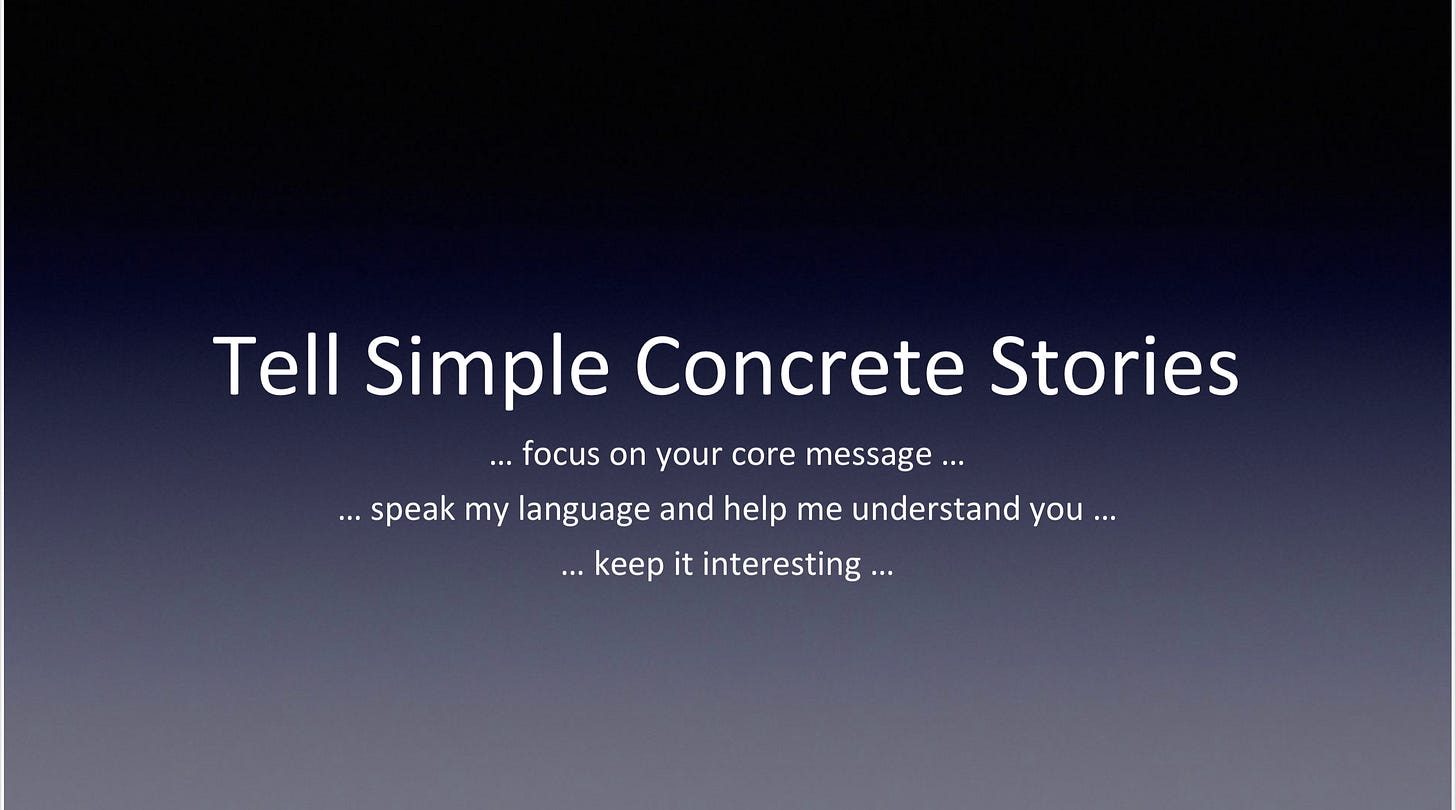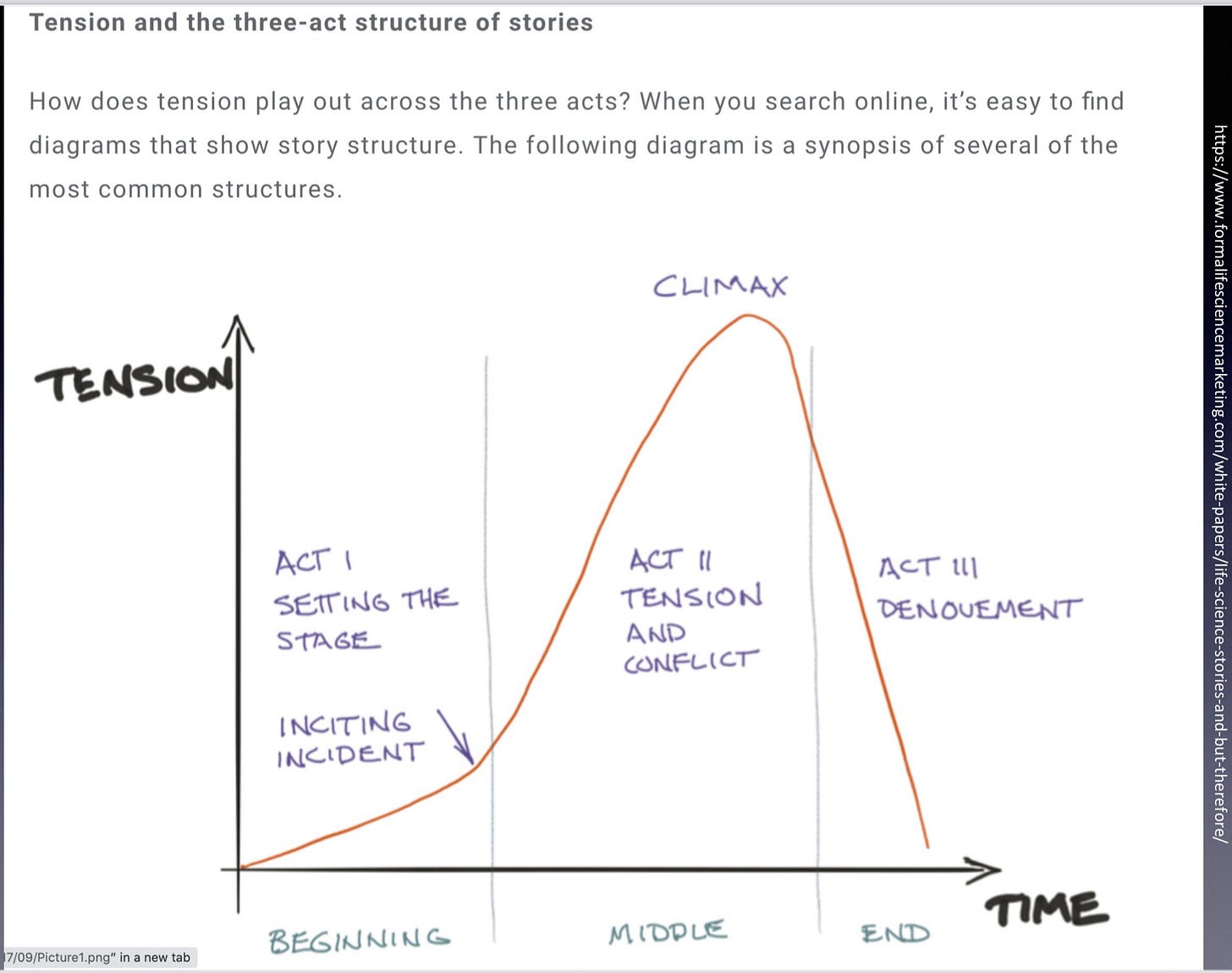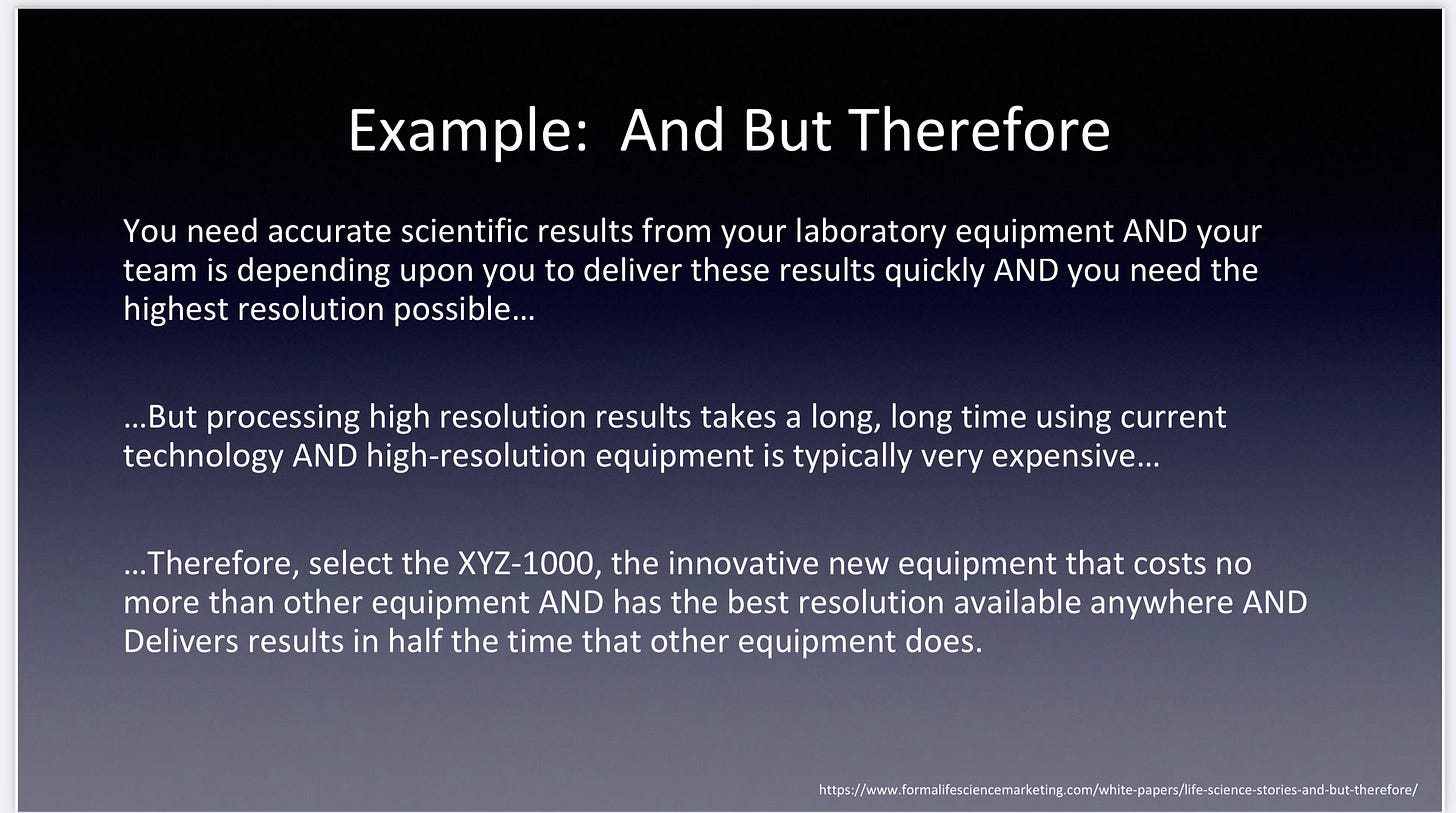In my experience, the Heath Brothers’ model for SUCCESs can be boiled down to:
Deconstructing SUCCESs
The concept “Simple” remains the same: what’s the core of your message? Can you relate it to an analogy or a high-concept pitch? Perhaps a proverb? If I only remember the most important thing you are trying to communicate - what do you want me to remember?
”Concrete” incorporates “Credibility”. Use sensory language and paint a picture with your words. Use a language and vocabulary that your audience understands. If you choose to use technical terms or jargon, couple it with concrete explanations and analogies to translate technical terms to your audience’s known experience. Use human-scale statistics.
“Stories” are made up of “Unexpected” and “Emotional” elements. Stories drive action through simulation (what to do) and inspiration (the motivation to do it). Your audience cares more about people than they do about numbers (remember Rokia from Made to Stick). Before your message can stick, your audience has to want it. Create curiosity, violate our known mental schemas, provide your audience some joy on your shared journey.
Storytelling in science-based presentations is challenging!!
Let’s face it, we aren’t creating Hollywood blockbusters. That said, the features of a good story are the same in your presentations as they are for Hollywood films!
In Storytelling in Life Science Marketing: Story Purpose and The And-But-Therefore Format, David Chapin provides examples from author and scientist Randy Olson who uses one word to epitomize each of the three acts and create a story template.
Act 1: And…
Act 2: But…
Act 3: Therefore.
Chapin goes on to demonstrate:
To highlight what makes stories sticky, I’m going to tell you a story. As you read this, pay attention to your reaction. At what point do you really get engaged in the story? At what point is it impossible for you to turn away—when does this story become a “page-turner?”
There was a man and
There was a woman and
They were married and
They had two kids and
They lived in a house and
The house was in a clearing in the woods and
The clearing was beautiful and
They had some pets and
They had a dog and
They had two cats and
One cat was white and
They had a goldfish and
The sun was shining and
The wind was blowing gently and
There were a few clouds in the sky and
The temperature was warm and
The kids were playing outside and
The dog was playing outside and
The dog was jumping and
There was a rocking chair on the porch and
There was a swing in a shady tree and
The swing was made from an old tire and
There was a garden behind the house and
There were beans and tomatoes growing in the garden and…
This is not a story; not yet.
Are you engaged? It’s unlikely. Are you engrossed? Almost certainly not. How long would this story stick in your head—for decades, like the story of the tortoise and the hare? No.
Why? Well, this is not a story; not yet, anyway.
To see how useful this And-But-Therefore template is:
First act:
There was a forest AND
There was a hare AND
The hare was boastful AND
The hare boasted he was the fastest animal in the forest AND
The animals were listening AND
The tortoise was listening too…
Second act:
But the tortoise challenged the hare to a race AND
The tortoise was slow AND
The hare rans so fast that he left the tortoise far behind AND
The hare stopped to eat some tasty plants AND
The hare fell asleep AND
The tortoise kept on plodding…
Third act:
Therefore the tortoise won the race AND
All the animals were cheering AND
The moral of the story is “slow and steady wins the race.”
In the first act of the Tortoise and the Hare, the thesis, we are introduced to the “normal world.” In this normal world, animals can talk and there are no humans. But in this world boasting is socially unacceptable, just as it is in our normal, human world. And just as it is in our world, hares are fast and tortoises are slow.
In the second act of this fable, the tension is introduced when the slowest animal issues a racing challenge to one of the fastest animals. The tension is increased as the race progresses; the hare runs so fast that he cannot even see the tortoise behind him. And the tension is increased again as the hare stops to eat a snack and then falls asleep in the sun.
In the third act, the tension is released when the tortoise crosses the finish line to the cheers of all the other animals. And the moral of the story is established.
But how do we do this in a scientific or technical presentation? Chapin provides an example:
ABT Statement
The National Socio-Environmental Synthesis Center provides a template for developing a short ABT statement for research:
[This is true and observable] and [this is true and observable OR this data exists], but [problem statement], therefore [this is how we are addressing the problem]_.
And allows you to hit two main points about your research. Focus on a relevant fact for the synthesis study. Or focus on an aspect of your topic you have researched for years but is new and interesting to your audience.
But introduces conflict! This is the heart of narrative storytelling. We transition away from the world as we knew into the reason why this research is necessary.
Therefore is a synthesis word that ties your goals together and promises to deliver a “resolution” to your audience. In this portion, address how your research will solve the problem articulated in the “But” statement. Your work may not be resolved, but by incorporating a resolving statement you can generate a connection between your work and your audience.
Share your experience or question for the cohort
What elements of the A-B-T framework have you used or seen used in your previous experience?
How does the A-B-T framework fit (or not fit) with the stickiest stories you can remember? This doesn’t have to be science … it could be a movie or a play or a book (fiction or nonfiction) that was particularly sticky for you.
If questions 1-2 are particularly challenging for you to answer from your own experience (i.e. nothing comes to mind), no worries, please just post a question here instead!
Click the comment button below to respond to the group!






Everybody loves Oreos. Bust out a secret pack of Oreos around hungry middle-schoolers on a hike and the excitement is tangible. Nothing is as interesting as those cookies you're holding in your hand. After the initial excitement is pacified with promises of cookies for all, everyone's eyes are on the tasty treat you're holding in your hand. It's that moment, with their eyes on the prize and silence in the group, you can use that tasty treat to demonstrate the thrilling topic of plate tectonics.
This is probably a way better example of a hook, or bargaining for attention with tasty rewards- but it's what comes to mind when I think of telling a tale.
Similar to Eric I have used the A-B-T framework in educational setting to offer information in a way that is accessible and interesting to kids. Plate tectonics are not always the most interesting to everyone, but with some help from an Oreo I've used the A-B-T framework to tell this tale of how the earth is covered with plates, and they have different densities (cookie vs. filling), but this means they move in different ways, therefore we have mountains and you get a cookie! Or something along those lines.
Also I really appreciate Biz's point climate futurism, and that narrative stories with an arc that people can follow are more powerful for inspiring action.
A large part of my environmental education background involved telling stories; partially to keep kids interested but mostly to help connect them to the subject matter I taught. The A-B-T framework is a necessary concept for storytelling, especially educational storytelling, because it requires a "therefore", a "why this matters" or "why this connects to me".
The stickiest stories for me always have a "therefore", or in other words some sort of opportunity for reader, listener, etc. growth. The film Everything Everywhere All At Once has an incredible "therefore" moment at the finale, which touches on the themes of family expectations, breaking cultural tradition, and personal growth in a way that felt incredibly relatable because it showed a very raw and emotional scene of growth for the main characters. The "Ands" and "Buts", the story connections led them to this point, but the "therefore" brought it all together because it showed a particular kind of value to the experiences the characters had in that they ended the film with a different understanding of themselves and their relationships than what they started with.
How does the A-B-T framework fit (or not fit) with the stickiest stories you can remember? This doesn’t have to be science … it could be a movie or a play or a book (fiction or nonfiction) that was particularly sticky for you.
If questions 1-2 are particularly challenging for you to answer from your own experience (i.e. nothing comes to mind), no worries, please just post a question here instead!